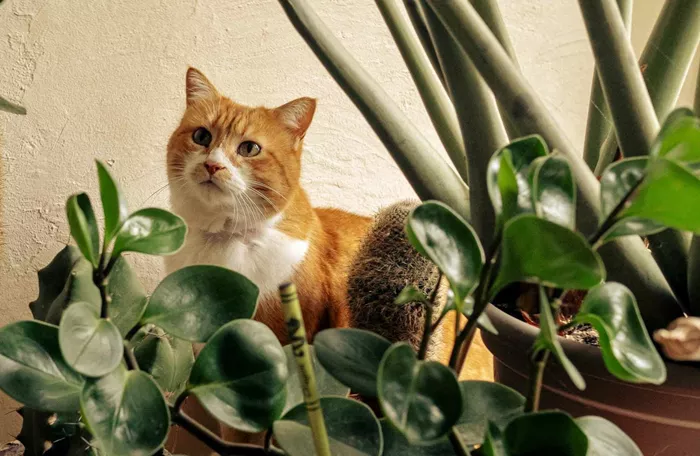As gardening enthusiasts, we cherish the beauty and tranquility that plants bring to our homes and gardens. However, for those of us who share our lives with feline companions, it’s crucial to be aware of the potential dangers that some common plants pose to our beloved cats. Cats are naturally curious creatures, and their tendency to nibble on greenery can lead to serious health issues if they ingest toxic plants. To help you create a safe and beautiful environment for both your plants and your feline friends, I’ve compiled a list of the 15 most toxic plants for cats, along with information on their toxic properties and the symptoms they can cause.
The 15 Most Toxic Plants For Cats
1. Lilies
Lilies are undeniably the most dangerous plants for cats. Specifically, plants belonging to the Lilium and Hemerocallis genera, such as Asiatic, Easter, Japanese show, rubrum, stargazer, tiger, Western, and wood lilies, as well as daylilies, are highly toxic. All parts of the plant, including the pollen, are poisonous, and even a small amount can cause severe kidney failure. Symptoms include vomiting, loss of appetite, lethargy, and ultimately, kidney failure. Even if pollen lands on a cat’s fur and they groom it off, it can be fatal.
2. Sago Palm
Sago palms are popular for their tropical appearance but are extremely toxic to cats. All parts of the plant contain cycasin, which causes severe liver damage, but the seeds are the most dangerous. Symptoms of sago palm poisoning include vomiting, diarrhea, black tarry stool, increased thirst, lethargy, liver failure, and death. The survival rate for cats that ingest sago palm is only 50% even with aggressive veterinary treatment.
3. Azaleas and Rhododendrons
These flowering shrubs and small trees contain grayanotoxins that disrupt sodium balance and negatively affect muscle function, including the heart. All parts of the plant are toxic, and even a small ingestion can cause poisoning. Symptoms include drooling, vomiting, diarrhea, lack of appetite, heart arrhythmias, weakness, tremors, temporary blindness, seizures, coma, and death.
4. Tulips
These popular spring flowers contain tulipalin A and B, which are allergens concentrated in the bulbs. While all parts of the plant are toxic, the bulbs contain the highest concentration of these dangerous compounds. Signs of tulip poisoning in cats include drooling, nausea, vomiting, diarrhea, difficulty breathing, and increased heart rate. Severe toxicity can lead to convulsions and cardiac abnormalities.
5. Chrysanthemums
Chrysanthemums contain various compounds that can be toxic to cats. The leaves and flowers are the most toxic parts. Even small amounts can cause vomiting, diarrhea, reduced appetite, excessive drooling, unsteadiness, and skin inflammation.
6. Daffodils
All plants in the Narcissus genus—including daffodils—contain lycorine with the highest concentration in the bulbs. Lycorine can cause drooling, vomiting, diarrhea, and abdominal pain. In severe cases, cats may experience cardiac arrhythmia or low blood pressure.
7. Cyclamen
These flowering plants often gifted during winter contain saponins that are highly toxic to cats. Ingestion can lead to severe gastrointestinal upset including vomiting and diarrhea; in severe cases it can even be fatal.
8. English Ivy
English ivy contains triterpenoid saponins which can be dangerous if ingested by cats. Its draping quality makes it a popular houseplant but it can be tempting for curious felines. The toxic properties in English Ivy can cause skin irritation along with vomiting and abdominal pain.
9. Dieffenbachia
Dieffenbachia is a common houseplant that is unfortunately highly toxic to cats. It contains insoluble calcium oxalates that can cause intense oral irritation when ingested along with excessive drooling and difficulty swallowing.
10. Kalanchoe
Kalanchoe is a succulent that can cause intestinal issues and affect a cat’s heart rate due to bufadienolides present in its tissues. This toxicity may lead to disorganized cardiac electrical activity resulting in an elevated heart rate or even cardiac arrest.
11. Lily of the Valley
Though not a true lily at all—Lily of the Valley is still toxic to cats due to cardenolides present within its structure which can lead to vomiting or irregular heartbeats.
12. Hyacinth
Hyacinth bulbs contain alkaloids that can be dangerous if ingested by cats; symptoms may include vomiting or bloody diarrhea along with depression or tremors.
13. Oleander
Oleander contains cardiac glycosides that may cause gastrointestinal tract irritation along with abnormal heart function or hypothermia; all parts of this plant are toxic to cats.
14. Yew
Yew contains taxine which is also toxic to cats; its bark needles along with its fruit pose significant risks leading to trembling coordination problems or respiratory distress.
15. Pothos
All parts of pothos contain insoluble calcium oxalate crystals making them toxic as well; ingestion may lead to oral irritation along with vomiting or difficulty swallowing.
By being informed about these toxic plants and taking necessary precautions you can create a safe yet beautiful environment for both your plants as well as your feline companions! If you suspect that your cat has ingested any of these harmful plants please contact your veterinarian immediately!


